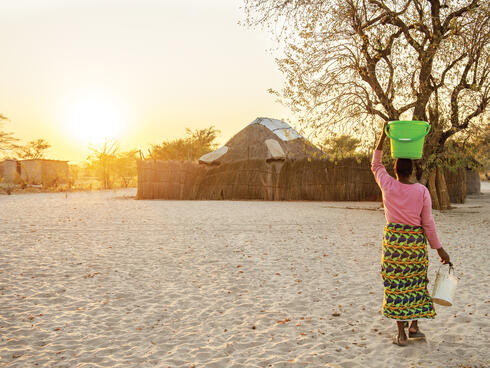
THE PEOPLE Bora, Muinane, Ocaina, and Uitoto Indigenous peoples
THE PLACE Predio Putumayo Indigenous Reserve, Colombia
WWF’S SUPPORT Strengthening Indigenous decision-making and governance
Roughly 3,000 people live in and around La Chorrera, a town in Colombia’s Predio Putumayo Indigenous Reserve. When the leaders of the territory gather here, in the traditional longhouse meeting place known as a maloca, some must travel three days by boat. In this remote community, the Indigenous organization Azicatch and WWF are working together to catalog the territory’s forest-based resources and create an environmental management plan to safeguard them for the future.
Hunting and fishing provide sustenance here, with families also tending one or two traditional chagras—small agricultural plots within the forest. “The fact that they live in their territory, and use it in the traditional ways, is what has kept these places healthy,” says WWF-Colombia’s Pia Escobar Gutiérrez, who manages WWF’s relationships with Indigenous organizations in the Amazon and leads the WWF team that works with Azicatch in La Chorrera. The over 14 million-acre territory is more than 90% intact.
But Escobar Gutiérrez says threats to the forest are “just around the corner,” including large oil and mining projects and young people losing their culture’s traditional knowledge.
To survey the forest, Azicatch assembled a technical team made up of representatives from the Bora, Muinane, Ocaina, and Uitoto peoples. The team included people trained in map reading and the use of GPS. Particular attention was paid to the inclusion of elders and women.
The team cataloged and analyzed key habitats, plants and animals, cultural sites, and “spaces of use,” says José Jesus Zafiama Piñeras, a biologist representing the Uitoto people. “A space of use is a place where we go to collect or gather what we need. It could be a chagra, or a settlement, or the river itself.”
Chela Umire, who represents the Muinane people, says it’s important to “get to know the whole area of the Muinane territory, to be able to preserve it and be able to say, ‘We are here. This is what we have. We haven’t destroyed it, and we have looked after it.’”
Preserving traditional knowledge is at the heart of the effort. “If there was no forest, we would lose all that knowledge,” says Zafiama Piñeras. “It would disappear from the minds of our children. What will we tell them about if we don’t have these forests?”
“We are here. This is what we have. We haven’t destroyed it, and we have looked after it.”
Chela Umire
Member of La Chorrera Indigenous Community

THE PEOPLE Indigenous women, youth, and elders
THE PLACE Brazilian, Colombian, Ecuadoran, and Peruvian Amazon
WWF’S SUPPORT Building capacity for Indigenous territorial governance
Women and young people represent nearly 70% of Indigenous Amazonians, yet historically they have been excluded from leadership. The Capacity Building Programme on Indigenous Territorial Governance aims to change that.
Created by a group of Indigenous organizations, universities, and environmental organizations including WWF, the program provides practical leadership training to Indigenous community members in Brazil, Colombia, Ecuador, and Peru. Of the four students nominated by each community, one must be a woman; one, a young person; one, an elder; and one, a community authority. The combination is based on research and is designed to encourage balanced perspectives, says WWF-Colombia’s Maria Fernanda Jaramillo, who works to disseminate knowledge across Indigenous networks. “It works perfectly,” she says.
Over the course of a year, students gain practical tools to manage the problems facing their communities. The multidisciplinary curriculum includes Indigenous laws and legal frameworks, territorial and communal governance, financial administration, globalization, and climate change. During the pandemic, students have met virtually; earlier, they convened for in-person instruction every other month and, in the interim, returned home to apply and continue their training with an Indigenous mentor.
The first cohort of students from 20 communities graduated in 2018, and so far the program has worked with more than 30 Indigenous groups.
“Territory is the basis of our existence as Indigenous peoples. In this program, we have studied many topics that strengthen us to be able to defend it against threats and protect it from harm.”
Leydi Burbano Santa Cruz
A Quillasinga woman and participant in the Capacity Building Programme on Indigenous Territorial Governance













